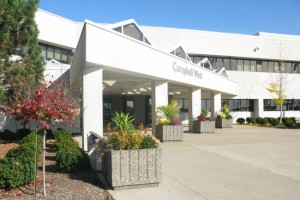By Ray Spiteri, Niagara Falls Review
It’s time to shrink Niagara Regional council, says incumbent Niagara Falls candidate Bart Maves.
“Having been there for four years, I believe we need to go from 30 regional councillors that are part-time regional councillors to eight full-time regional councillors,” Maves said during a debate at the Gale Centre Tuesday night.
“I think it’s … too big a body,” he said of the Region, which has a $1-billion budget. “I think you need to have people there instead of coming in from work for an hour and then going back out and coming in again for another hour, I think we should take, basically the four ridings that make up the Niagara region, which would be cross municipality, and make two people be elected to represent the riding.”
Incumbent Barbara Greenwood said she supports reducing the size of regional government from 30 to 18 members.
She said the 12 mayors that sit on regional council should be removed.
“When the regional government was first formed, the mayors were brought into the fold because of their expertise in their communities to get a better understanding about how they function, but they weren’t supposed to stay, but they’re still there,” said Greenwood. “That’s one third of a million dollars a year in salaries going to the mayors alone.”
Candidate Bob Gale said regional council should be “at least” cut in half and there should be term limits on councillors.
He said there also needs to be more “checks and balances” at the Region.
“Once you can trust it, then get the mayors out of there. But right now, I trust city councils more than I trust the Region because I can see where my roads are plowed, where the sidewalks are repaired, but we haven’t got a clue what’s going on with the Region,” he said. “By me saying (the Region is) $436 million in debt, no one here knew that. No one here pays attention to the Region at all.”
Candidate Anne Angelone said getting the number of people sitting on regional council “on track” would “save a heck of a lot of money,” but the “exact number I couldn’t give you.” She said having the mayors sit on both city and regional councils gives them a “little bit too much power.”
Candidate Paul Downie said the real “elephant in the room” is the number of unelected commissions, authorities and boards across Ontario.
“Right now, there’s duplication that has to be eliminated,” he said. “There’s 864 commissions, authorities and boards that are unelected and somebody has got to solve that problem.”
Incumbent Selina Volpatti said there’s more important issues to deal with.
“What I found at the Region in the four years I’ve been there … is that every time we discuss governance, we lose our focus, we take our eyes off the ball, which is jobs and economic development,” she said. “I’m tired of hearing the word, I don’t want to talk about it, it is what it is, let’s get on with it and let’s work with it and let’s make it work.”
Candidate Jeannette Tossounian agreed, adding “I really don’t think this issue is even important at all. To tell you the truth, I don’t care.”
But others across Niagara do, including incumbent St. Catharines candidate Bruce Timms.
Timms said he would like to see elected municipal councillors service double duty, meaning they would sit full time on both municipal and regional council.
It’s a recommendation a City of St. Catharines governance committee recommended to the Garden City’s council, but was rejected, said Timms.
“The numbers issue misses the point,” he said. “It’s about how Niagara, as a team of 12 municipalities, can come together as a team. It’s not working as a team right now. We’ve got 12 players who are not in the same locker room. There’s a disconnect between the cities and the Region, meanwhile 46% of your tax bill the city issues is regional costs.”
He said having city councillors also elected to be regional councillors would bring “all the Region issues to the city table for discussion, as well as bring all the city issues to the Region.”
Incumbent St. Catharines candidate Brian Heit said he would like to see some municipalities, such as Wainfleet and Port Colborne, and Lincoln and West Lincoln, amalgamate to equal three or four communities, or all municipalities come together as one Niagara.
“Eliminate the Region and eliminate the 12 municipalities and rejig how you elect people — have them in wards or by population,” he said. “We could better market ourselves locally and throughout Ontario, Canada and internationally as a Niagara hub.”
Heit said amalgamation would save money and allow Niagara to tap into more funding from the provincial and federal governments. He said in some instances, upper levels of government distribute money to municipalities based on their population. If Niagara were to request money as a community representing 437,000 people, as opposed to each municipality fighting each other for a piece of the pie, residents would benefit.
“We are Niagara. Getting rid of all these boundaries would help us in the long run.”

